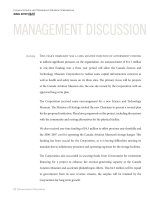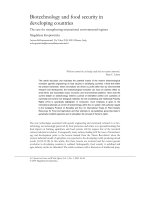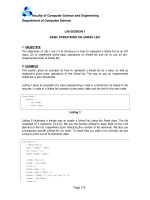science and computers - lec 9
Bạn đang xem bản rút gọn của tài liệu. Xem và tải ngay bản đầy đủ của tài liệu tại đây (30.32 KB, 5 trang )
Lec9 – mini lecture
• More fractals – Julia sets
1
Julia sets
Consider the very simple non-linear map
x
n+1
= x
2
n
−
3
4
For most starting values of x the final x = ∞!
In fact x only remains bounded if |x| < 3/2
See by drawing graphs of y = x and y = x
2
−
3
4
• The boundary between the two regions in x
(diverging and non-diverging) is called the
Julia set of the map and contains seem-
ingly 2 points x = −
3
2
and x =
3
2
• Things much more interesting if we allow
ourselves to consider complex numbers
2
Complex numbers
Summary:
• Complex number has 2 parts – real and
imaginary
z = x + iy
• Needed to give answer to question: what
is square root of a negative number.
• Add/subtract by adding/subtracting corre-
sponding parts
• Multiply out using usual rules and collect
terms together with the simple rule i
2
=
−1
• Magnitude |z| =
(x
2
+ y
2
)
3
Maps of complex numbers
Consider previous map for complex numbers
z
n+1
= z
n
∗ z
n
−
3
4
• What is now the region in which |z| diverges
under iteration of the map ?
• The region of convergence is called the
filled-in Julia set B and the boundary be-
tween between diverging and non-diverging
sets is the true Julia set of the map.
• Remarkably it is a fractal !!
• The boundary is rough on all scales.
4
Other Julia sets
Try general maps f(z) = z
2
+ a with
• a = −0.85 + 0.18i
• a = −1.24 + 0.15i
• a = −0.16 + 0.74i
In lab will add zooming feature which will demon-
strate this structure on all length scales.
5









